Darkfield Digital Image Gallery
Grasshopper Malpighian Tubules
The challenges of survival for terrestrial insects such as the grasshoppers (order Orthoptera) include conserving water, particularly in arid regions of the world including the deserts and grasslands. As excretory organs, the Malpighian tubules not only get rid of nitrogenous wastes, they help properly maintain the internal ionic balance of the insect.

View a second image of grasshopper Malpighian tubules.
Named for the famous seventeenth century Italian biologist and microscopist, Marcello Malpighi, terrestrial insects use Malpighian tubules to eliminate the end products of nitrogen metabolism, and through uricotely, to conserve water. Furthermore, by eliminating the need for as much water as would be necessary to excrete ammonia in solution, flying and jumping insects such as grasshoppers are not as heavy, reducing the load on their muscles and limbs. Birds follow a similar strategy of waste elimination. Uric acid is synthesized by the insect's tissues and released in soluble form into the hemocoel. The uric acid is absorbed by the Malpighian tubules and the low pH in the tubule lumen causes uric acid to precipitate out as dry matter. The nitrogen waste is excreted with other solid waste through the anus of the grasshopper. In contrast to highly toxic and very water-soluble ammonia (aquatic insects and fishes), urea (humans, land mammals and amphibians) is less toxic and requires less water for removal while uric acid (birds, reptiles and insects) is a harmless crystalline solid. Within the eggs of the grasshopper, insoluble uric acid crystals can be safely stored until hatching without upsetting the delicate osmotic balance or creating toxic effects on growth, development, and survival.
Grasshoppers are excellent models for insect anatomy and physiology since they are relatively unspecialized and retain many of the characteristics of the primitive ancestral insect. The grasshopper's tubules, as with other insect Malpighian tubules, discharge into the posterior region of the gut tube (the hindgut) and function in a similar fashion to the kidneys of higher terrestrial animals. In contrast, aquatic insects eliminate nitrogenous wastes as ammonia using nephridia.
Contributing Authors
Cynthia D. Kelly, Thomas J. Fellers and Michael W. Davidson - National High Magnetic Field Laboratory, 1800 East Paul Dirac Dr., The Florida State University, Tallahassee, Florida, 32310.
BACK TO THE DARKFIELD IMAGE GALLERY
BACK TO THE DIGITAL IMAGE GALLERIES
Questions or comments? Send us an email.
© 1995-2025 by Michael W. Davidson and The Florida State University. All Rights Reserved. No images, graphics, software, scripts, or applets may be reproduced or used in any manner without permission from the copyright holders. Use of this website means you agree to all of the Legal Terms and Conditions set forth by the owners.
This website is maintained by our
Graphics & Web Programming Team
in collaboration with Optical Microscopy at the
National High Magnetic Field Laboratory.
Last Modification Friday, Nov 13, 2015 at 01:19 PM
Access Count Since September 17, 2002: 15198
Visit the website of our partner in introductory microscopy education:
|
|
